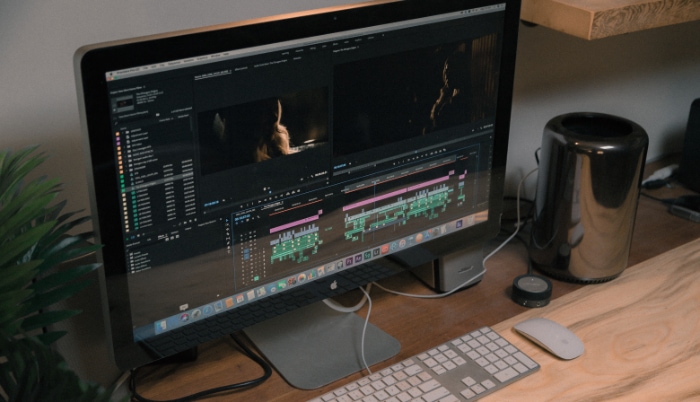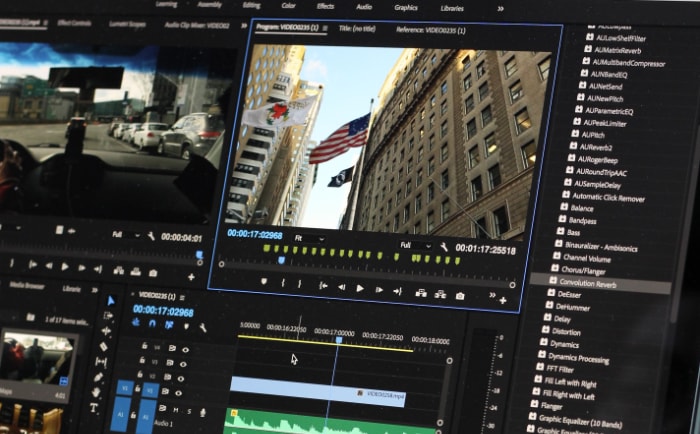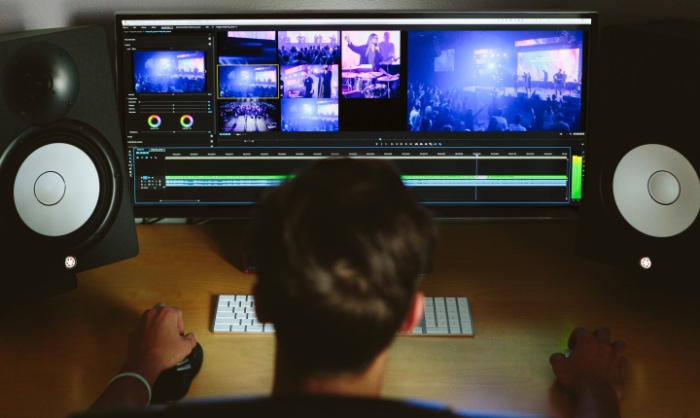What Is Rendering in Video Editing? A Detailed Explanation

The realm of video editing is dynamic and multifaceted, encompassing various technical processes and creative manipulations. Among these, one term often stands out, creating a fair bit of curiosity and sometimes even confusion – “Rendering”.
Whether you’re a seasoned professional or a novice dabbling in the art of video editing, understanding the concept of rendering is essential. This process, although technical, is the backbone of converting your raw footage and creative effects into a seamless visual experience.
Understanding Video Editing
Video editing is the process of manipulating and arranging video shots to create a new work. It involves cutting segments (trimming), adding segments (joining), and rearranging the sequence of clips in a video, among other procedures.
This craft is an integral part of post-production and transforms raw footage into a polished, cohesive narrative that communicates the desired message or story.
The Video Editing Process
The video editing process, at its core, is about storytelling. It begins with the importation of raw video files into video editing software.
Next comes the organization of these clips into a sequence that makes sense to the story being told, also known as the ‘rough cut’. This phase is followed by the ‘fine cut’, where the editor refines the video, fine-tuning the pacing, rhythm, and flow of the narrative.
In addition, other elements like music, voiceover, sound effects, titles, transitions, and special effects are added to enrich the storytelling and create a desired emotional impact. The last phase is the final review and rendering, where the edited video is exported into a suitable format for distribution and viewing.
The Importance of Video Editing in Today’s Digital World
In our modern, digital age, video editing has taken on greater significance than ever before. It’s not just about making movies or television shows anymore; it now permeates every facet of our digital lives.
From social media content, vlogs, commercials, and corporate presentations to educational tutorials and online marketing, video editing plays a crucial role.
Video editing allows us to transform simple footage into engaging content, keeping viewers hooked and effectively conveying our intended message. It provides us the power to control the narrative, pace, and mood of the video, ultimately enhancing viewer experience and interaction.
Video editing is an art that demands both technical proficiency and creative acuity. The next time you sit down to edit, remember that each cut, transition, and effect is an opportunity to tell a more compelling story.
Rendering: A Deep Dive
In the realm of video editing, rendering refers to the process of generating a final video product from different elements like raw footage, audio files, visual effects, or animation. In essence, it is the computer’s task of processing all the information, calculations, and data to produce a viewable video file.
The Rendering Process Explained
Rendering involves several steps, and understanding these can significantly impact the efficiency and effectiveness of your video editing workflow. Here’s a closer look at the different stages:
Rendering Raw Footage: The raw footage captured by cameras is usually in a format that is hard for the computer to process directly. During rendering, the computer processes this footage to make it more manageable, converting it into a format that’s easier to work with.
Rendering Effects and Transitions: When you add effects, transitions, text, or animations to your video, these elements need to be rendered. The computer calculates how these elements interact with the underlying video to create new frames.
Final Rendering or Exporting: Once you’ve finished your editing work, the final video has to be rendered or exported. The computer processes all the information – raw footage, effects, transitions, overlays – to create a single, final video file.
This file is in a format suitable for distribution, whether online or through other media.
The Intricacies of Rendering

While rendering may sound straightforward, it’s a highly complex process under the hood. The computer needs to calculate the color, brightness, and contrast of every pixel in each frame – and there could be millions of pixels in one frame and thousands of frames in one video.
Additionally, effects and transitions complicate these calculations even further.
It’s also worth noting that different video editing programs handle rendering differently. Some software performs rendering in real-time as you work, allowing for smoother playback during editing.
Others may require you to manually initiate rendering to see the final effect of your edits.
In the end, rendering is a vital cog in the video editing machine, breathing life into your creative vision.
Why Rendering is Crucial in Video Editing
Now that we have a basic understanding of what rendering is, let’s explore why it holds such a critical place in the video editing process. Its relevance extends far beyond just technical necessity.
Enhancing Video Quality
One of the fundamental reasons why rendering is crucial in video editing is the improvement it brings to video quality. Rendering processes every pixel of your video and optimizes it for the best possible output. This procedure ensures smooth transitions, sharp visuals, and a final video that truly reflects your creative vision.
Facilitating Efficient Workflow
Rendering plays an essential role in the efficiency of the video editing process. When you apply effects, transitions, or edits to your video, it may start to lag or become choppy during playback due to the immense processing power required.
Rendering these changes allows you to preview your edits smoothly, thereby streamlining your editing workflow and saving precious time.
Preparing for Final Output
Rendering is the final step in the video editing process that combines all the edits, effects, transitions, and layers into one single file. This step is vital because it prepares the video for distribution and viewing on various platforms.
Without rendering, your raw edits would remain unprocessed, and your audience would be unable to enjoy the final product.
Accommodating Effects and Transitions
Most effects and transitions are too complex to be processed in real-time during editing. Rendering these elements lets you preview how they will look in the final video.
It also allows you to make necessary adjustments before committing to the final output.
Balancing Quality and File Size
Rendering not only focuses on achieving the best quality output but also takes into consideration the file size and format. Depending on your final delivery platform, you might need to balance between file size and quality.
Rendering helps to achieve this delicate balance, producing a video that maintains quality but is also easily shareable and not too large for storage or streaming.
Rendering in video editing is not just a necessary process; it’s what takes your collection of raw files, edits, and enhancements and turns them into a polished, cohesive video. By understanding its importance, you can better appreciate the time and computing power it requires and plan your editing process accordingly.
Factors that Influence Rendering

Like any complex process, rendering doesn’t occur in a vacuum. Various factors influence how rendering occurs and the results it yields.
Here, we will explore some of these key elements.
The Role of Hardware
The quality and speed of your computer’s hardware significantly influence the rendering process. Let’s break down the key components:
CPU (Central Processing Unit): The CPU is like the brain of your computer and plays a crucial role in rendering. The more cores and higher clock speed your CPU has, the faster it can render video.
GPU (Graphics Processing Unit): While traditionally rendering was primarily a CPU-driven process, modern video editing software increasingly leverages the power of the GPU. A powerful GPU can drastically accelerate rendering times, particularly when dealing with graphics-intensive tasks.
RAM (Random Access Memory): Adequate RAM is necessary for smooth rendering, especially for complex projects with high resolutions or multiple effects. More RAM allows your computer to process more data simultaneously, improving rendering speed.
Role of Video Editing Software
Different video editing software have different capabilities and use different methods for rendering. Some software may render faster but compromise on quality, while others may take longer but deliver a superior output.
The efficiency of the rendering algorithm, how well it leverages hardware, and the level of optimization for different video formats all come into play here.
Video Resolution and Format
The resolution of your video significantly impacts the rendering process. Higher resolution videos like 4K or 8K require more processing power and take longer to render than standard 1080p videos.
Furthermore, different video formats have different compression algorithms, which also influences the speed and efficiency of rendering.
Complexity of Edits
The number of layers, effects, transitions, and color corrections in your video project also affects rendering times. The more complex your project, the longer it will take your computer to calculate and process all the information during rendering.
Output Settings
The settings you choose for the final output, such as the file format, codec, resolution, and bitrate, can also affect the rendering process. Some formats and codecs are more processor-intensive to encode, while higher bitrates and resolutions produce larger file sizes, which take longer to write to disk.
Understanding the factors that influence rendering can help you make informed decisions during the editing process, such as optimizing hardware and software choices, selecting appropriate project settings, and managing the complexity of your edits to ensure efficient rendering times.
Types of Rendering
Understanding the different types of rendering used in video editing can give you a better grasp on when and how to apply them effectively in your workflow. Here are some key types of rendering:
Real-Time Rendering
Real-time rendering is primarily used in live broadcasting and video gaming where there’s no luxury of time to pre-render graphics. The aim here is to render graphics as quickly as possible, providing the viewer with a seamless and uninterrupted experience.
The challenge is to ensure a balance between the speed of rendering and the quality of the graphics, and sophisticated hardware and software are required to achieve this effectively.
Pre-Rendering
Pre-rendering, also known as offline rendering, is used when there is no time pressure to deliver the final output, such as in film and TV production. This type of rendering allows for higher-quality images and animations because the computer has more time to calculate and apply things like complex effects, realistic textures, and lighting.
Pre-rendering can be a time-consuming process but provides a high level of detail and realism.
Background Rendering
Background rendering is a process where rendering takes place in the background while other tasks continue on the computer. This type of rendering is often used in video editing software to allow the editor to continue working without interruption. While background rendering might slow down other computer operations, it enables a smoother editing experience and faster final export.
Network Rendering
Network rendering, also known as distributed rendering, involves using multiple computers on a network to render a single project. This type of rendering can significantly reduce rendering time and is especially useful for large, complex projects.
Each machine on the network works on a small part of the project, and all these parts are combined to create the final output.
Each type of rendering serves different purposes and requirements. Depending on the specifics of your project, time constraints, and available resources, you may use one or more of these rendering types to achieve the best results.
Understanding these types helps you make an informed choice and optimizes your video editing process.
Tips to Optimize the Rendering Process

Optimizing the rendering process can drastically improve your video editing workflow, saving you time and resources. Here are some tips to help you achieve a more efficient rendering process:
Hardware and Software Optimization
Upgrade Your Hardware: Invest in a powerful CPU, a robust GPU, and as much RAM as you can afford. These will significantly speed up the rendering process.
Use an SSD (Solid State Drive): SSDs can read and write data much faster than traditional HDDs, reducing the time it takes to save your rendered video.
Keep Your Software Up-to-Date: Video editing software developers continually optimize their rendering engines for better performance. Keeping your software updated ensures you’re benefiting from these improvements.
Using Proxies for Smoother Editing
If you’re working with high-resolution footage that’s slowing down your computer, consider using proxy files. These are lower-resolution versions of your video files that are easier to edit.
Once you finish editing, you can replace the proxies with the original high-resolution files for the final render.
Efficient Use of Effects and Transitions
Try to use effects, transitions, and layers sparingly. Each additional effect increases the rendering time.
If you’re using multiple effects, see if there are ways to achieve the same result with fewer layers or effects.
Select Appropriate Output Settings
Your output settings should match your delivery platform. For example, if you’re delivering to a platform that supports 1080p resolution, there’s no need to render your video in 4K.
Also, consider the file format and codec. Some formats and codecs are more efficient and deliver a good balance between quality and file size.
Pre-render Complex Segments
If your project has complex segments with lots of effects and layers, consider pre-rendering these parts. This can make the final rendering process faster, as these parts are already rendered and can be processed more quickly.
Implementing these tips can significantly improve your rendering times, making your video editing process smoother and more efficient. Remember, the key to a streamlined rendering process is a combination of powerful hardware, optimized software, and thoughtful editing practices.
Conclusion
Understanding rendering in the context of video editing is a must for anyone keen on producing quality video content. It’s a complex but vital process that takes your raw footage, edits, transitions, and effects and combines them into a cohesive, viewable video.
The rendering process also significantly influences the quality, efficiency, and final output of your video project.
With an understanding of what rendering is and how it functions, coupled with the knowledge of factors that influence it, you can better navigate the world of video editing.
Whether it’s optimizing your hardware, making smart choices about your editing software, or using rendering types to your advantage, every little insight can help improve your workflow and the quality of your videos.
Moreover, by following the tips for optimizing the rendering process, you’ll not only speed up your editing workflow but also enhance the final quality of your videos.
To wrap up, while rendering might seem daunting, it’s an integral part of the video editing process that every video editor should familiarize themselves with. So the next time you sit down to edit a video, remember the role of rendering and use it to bring your creative vision to life in the best possible way.
After all, every pixel counts in the realm of video editing, and the art of rendering ensures that each one tells your story just as you envisioned.


